When renowned Oglala Lakota chef Sean Sherman reflects upon his culinary journey returning to indigenous ingredients to create innovative, traditionally-inspired dishes, he recalls, “In an epiphany, I tasted how food weaves people together, connects families through generations, is a life force of identity and social structure. (1) These formidable themes are central to recent Caldecott Award books that delve into traditions around food, families, and friends.
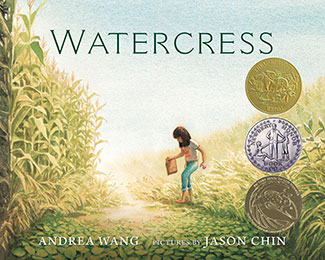 This picture book sampling begins with the 2022 Caldecott Medal book Watercress, written by Andrea Wang and illustrated by Jason Chin. Inspired by author Wang’s childhood experiences, the story recounts a girl’s shame as her family stops on the side of the road to gather watercress. Once home at the dinner table with her parents and brother, the girl refuses to touch the greens. Her mother takes this opportunity to share the story of her own childhood, experiencing China’s great famine and an indelible loss.
This picture book sampling begins with the 2022 Caldecott Medal book Watercress, written by Andrea Wang and illustrated by Jason Chin. Inspired by author Wang’s childhood experiences, the story recounts a girl’s shame as her family stops on the side of the road to gather watercress. Once home at the dinner table with her parents and brother, the girl refuses to touch the greens. Her mother takes this opportunity to share the story of her own childhood, experiencing China’s great famine and an indelible loss.
For the watercolor illustrations (2) rendered in a realistic style, Chin chooses a “color palette heavy in yellow ochre, which reminds me of old photographs and 1970s décor, and cerulean blue, which is similar to the blue often used in Chinese paintings.” (3) Because the story moves between the American Midwest and China, the illustrator “tried to incorporate some aesthetic elements from Chinese painting…[with] many soft washes and empty spaces … to represent the theme of memory that runs throughout the story.” (4) Chin uses a combination of Western and Chinese brushes to ”make the art a kind of visual blending of culture.” (5)
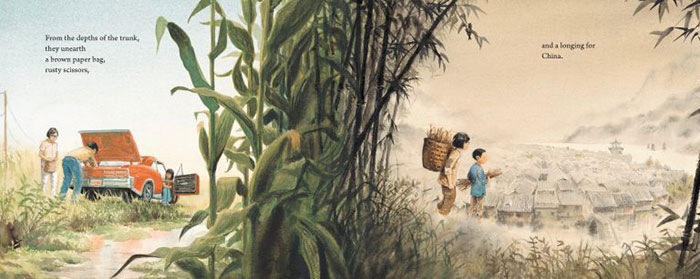
published by Neal Porter Books / Holiday House, 2021
In a story centered on emotion, rather than action, subtle horizontal and diagonal lines lead readers’ eyes across the images. Page layouts vary from expansive full-bleed double-page spreads to restrained single-page spreads. Particularly striking is the image of the family preparing to forage on the verso, with stalks of corn melding to bamboo on the verso, which shows the mother and her brother as children gathering wood outside their Chinese village. Here, warm pastels transform to sepia tones to indicate the shift in time and place, foreshadowing the interior home scenes from China later in the book. The wraparound dust jacket echoes this earlier spread, with changing vegetation separating the American protagonist on the cover and siblings in China on the back. Removing the dust jacket reveals a cover filled with wild watercress.
In the creation of most picture books, the author and illustrator do not communicate directly, instead work through an editor. However, after Chin agreed to take on the project, Wang sent him several family photos and recommended that he visit the Peabody Essex Museum and the Harvard University Yenching Library for visual research on China. These resources helped Chin learn about “culture and history so that the images would be accurate, but also so I could get to know where these characters were from and who they were.” (6) This Caldecott Medal book, “both an apology and love letter to [Wang’s] parents,” (7) has the unique distinction of also garnering a Newbery Honor for its distinguished contribution to American literature for children.
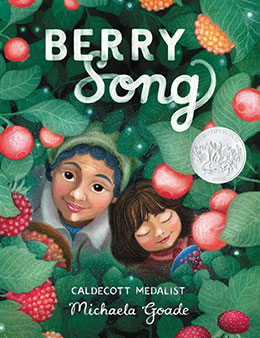
An intergenerational foraging tale that sets a more joyful mood is Berry Song. Author-illustrator Michaela Goade’s 2023 Caldecott Honor book exudes delight and reverence as a girl and her grandmother gather berries throughout the year. Organic shapes and curved lines dominate the lush watercolor and mixed media illustrations (8) that reflect the colors of the seasons in a blend of realistic and surrealistic styles.
Set in the Tongass National Forest in southeast Alaska, the home of Goade’s Tlingit relatives and where she was born and raised, the story celebrates the abundance of the land. Here, the berries sing, the gatherers sing, and the ancestors sing. With each season, a lilting chant flows across the page, naming the berries that will fill the pair’s buckets. The page designs include a variety of full-bleed and framed double-page and single page spreads, with leaves, needles, and moss blanketing each image. Transparent, almost ghostly, leaves appear in the forest and even upon the faces and hair of the grandmother and child, while ethereal white or rose light infuses each illustration. “[T]he wide, wild sea” and winding rivers roll across many spreads, reinforcing the connection between land and water. The story ends with the protagonist leading a younger sibling into the forest to share her knowledge of and love for berry-gathering, carrying on the family and cultural tradition.

published by Little, Brown / Hachette, 2022
Berries and their plants fill the front and back endpapers, identified in Tlingit and English. The front of the book jacket features the grandmother and grandchild peeking out from berry bushes; removing the jacket shows the cover image with the girl and her sister amidst the berries, the new generation of gatherers.
Of Tlingit and Haida heritage, Goade was the first BIPOC woman illustrator to win the Caldecott Medal in 2021 for We Are Water Protectors. She came to book illustration as a visual artist and admits that she needed to learn the nuance of the craft. “[Picture book illustration is] its own art form [with] things like the page turn and pacing and narrative storytelling and all of these different elements that I wasn’t familiar with.” (9) Berry Song is her first self-authored picture book. “…[G]oing into the experience of writing the story and then illustrating it…just felt like coming home. Like I could take all of that experience and return to where I started illustrating and where I grew up.” (10)
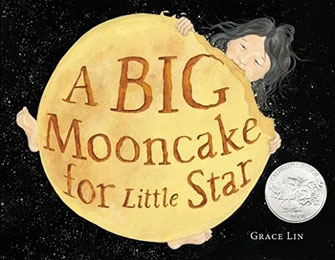
Author-illustrator Grace Lin also explores a family and cultural tradition in A Big Mooncake for Little Star, a 2019 Caldecott Honor book. For the Asian Moon Festival, a girl and her mother make an enormous mooncake. Mama asks Little Star not to touch the treat, but the girl can’t resist temptation, nibbling bits of the big mooncake perched high in the sky each night.
The visual narrative begins in the wordless front endpapers and title page that follow the preparation of the mooncake before the text begins. Lin recounts how this story “could only be told with [a] picture book — we read the story of Little Star sneaking bites of the mooncake — but we see how her bites make the cake into the phases of the moon and the crumbs become stars. Without the picture book format to tell and slowly reveal both stories, the book would lose all wonder and artistry.” (11) At the end of the tale, Mama and Little Star embark on making another mooncake, and the story comes full circle with the back endpapers, identical to those in the front.
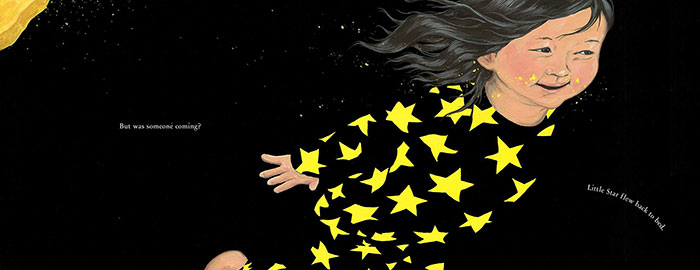
published by Little, Brown / Hachette, 2018
Lin uses a limited palette of golden hues, black, and tan, with some whites and blues. Popping off the page, the gouache paintings on white watercolor paper (12) are set directly on velvety black backgrounds. Spare compositions and implied horizontal and diagonal lines convey a playful narrative on the long horizontal double-page spreads. Lin describes her style for this “fantastical story” as magical realism. (13)
Not surprisingly, thematic shapes recur throughout the story, with the circular round moon and its various phases, and the stars of Little Star’s and Mama’s pajamas. Fine splattering of crumbs dance across the pages like the Milky Way. The dust jacket and book cover reinforce these features: the dust jacket is almost filled by the titular mooncake, while the wraparound cover replicates the spread of Little Star munching on the various phases of the waning mooncake.
The author-illustrator calls the book a “love letter” to her daughter, who provided inspiration for the story when the two first made mooncakes together while Lin told the traditional stories of the Moon Lady and the Jade Rabbit. The picture book is also her homage to Robert McCloskey’s Blueberries for Sal, a classic that she “loved as a child, yet yearned to see someone that look[ed] like me — someone Asian — in.” (14) The kitchen scene depicted on the endpapers for … Mooncake … mirrors that portrayed on the endpapers for Blueberries … and also includes hidden references to the 1949 Caldecott Honor book. (15)
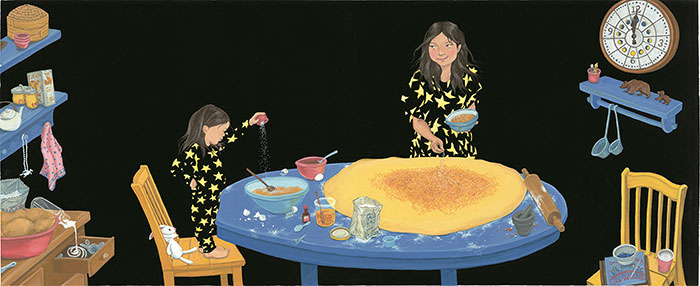
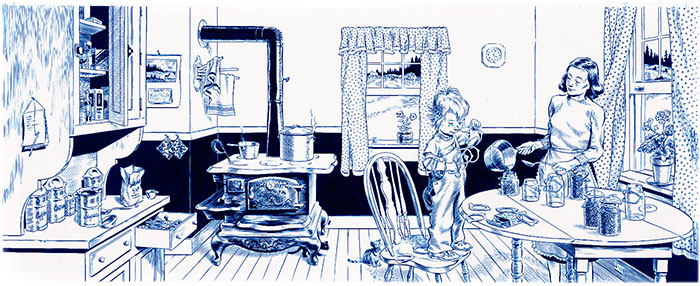
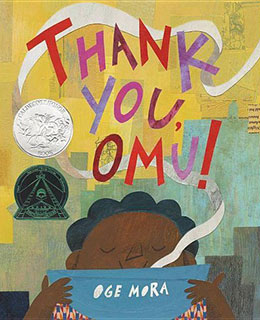
In contrast to an intimate, whimsical mother-daughter bedtime story, Thank You Omu! introduces a generous cook and the myriad residents in her bustling neighborhood. When Omu decides to make “a thick red stew in a big fat pot for a nice evening meal” for herself, the enticing smell draws young and old to her door. With each arrival, bowl by bowl, Omu shares her stew until nothing remains for her. However, appreciative neighbors have not forgotten the woman’s kindness.
To create the bold abstract collages for this 2019 Caldecott Honor book, author-illustrator Oge Mora uses acrylic paint, china markers, pastels, patterned paper, and old-book clippings. (16) Mora explains that “The thing I love most about collage is that you can’t master it. You can put all the intention you desire into it, and the medium will find new and inventive ways to humble you every time. The medium’s ability to surprise me makes it so exciting.” (17)
All the illustrations are full-bleed double-page spreads that cannot contain the allure of Omu’s stew. Mora gives readers a clue to the next guest to arrive, always in view on the previous page. The front endpapers show an aerial view of Omu’s neighborhood in the daytime as the aroma wafts through, while the back endpapers show the neighborhood at night, chronicling the timeframe of the story.

published by Little, Brown / Hachette, 2018
Mora’s grandmother provided the impetus for the story. The book began as a single illustration of the woman’s stew, a piece Mora completed for a class assignment at the Rhode Island School of Design. For the final project, Mora expanded the image into a picture book dummy, which caught the eye of a visiting art director from Little, Brown. By the next semester, the student artist was editing the manuscript and creating sketches for the publisher. (18) In the Author’s Note, Mora relates how her grandmother loved to cook and share the bounties: “Everyone in the community had a seat at my grandmother’s table,” the same giving spirit that the fictional Omu radiates. “Omu” is the word for “queen” in the Nigerian language of Igbo; however, as a child, Mora used the term for her Grandma.
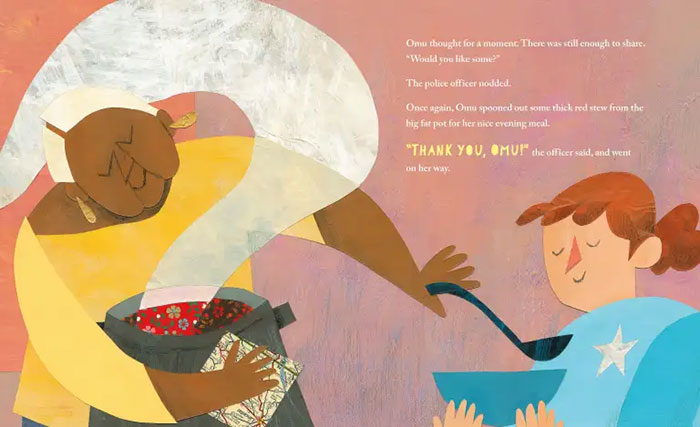
published by Little, Brown / Hachette, 2018
In closing, chef and humanitarian José Andrés recognizes “the power of food to evoke memory, to bring people together, to transport you to other places.” (19) These Caldecott Award books hold this same power and offer nourishment to the soul. Bön appétit!
More Caldecott Books Featuring Food
Bang, Molly. The Grey Lady and the Strawberry Snatcher. New York: Four Winds, 1980. (1981 Caldecott Honor)
Brown, Marcia. Stone Soup. New York: Scribner, 1947. (1948 Caldecott Honor)
de la Peña, Matt. Last Stop on Market Street. Illustrated by Christian Robinson. New York: Putnam’s Sons/Penguin, 2015. (2016 Caldecott Honor)
de Paola, Tomie. Strega Nona. Hoboken, NJ: Prentice-Hall, 1975. (1976 Caldecott Honor)
Goffstein, M.B. Fish for Supper. New York: Dial, 1976. (1977 Caldecott Honor)
Phi, Bao. A Different Pond. Illustrated by Thi Bui. Mankato, MN: Capstone, 2017. (2018 Caldecott Honor) Author Andrea Wang considers this book her “mentor text” for Watercress. (20)
Reynolds, Aaron. Creepy Carrots!, Illustrated by Peter Brown. New York: Simon & Schuster, 2012. (2013 Caldecott Honor)
Sawyer, Ruth. Journey Cake, Ho! Illustrated by Robert McCloskey. New York: Viking, 1953. (1954 Caldecott Honor)
Scheer, Julian. Rain Makes Applesauce. Illustrated by Marvin Bileck. New York: Holiday House, 1964. (1965 Caldecott Honor)
Sendak, Maurice. In the Night Kitchen. New York: Harper and Row, 1970. (1971 Caldecott Honor)
Books Cited
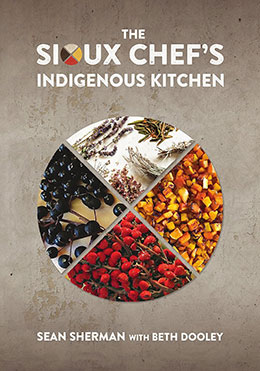 Goade, Michaela. Berry Song. New York: Little, Brown/Hachette, 2022.
Goade, Michaela. Berry Song. New York: Little, Brown/Hachette, 2022.
Lin, Grace. A Big Mooncake for Little Star. New York: Little, Brown/Hachette, 2018.
Lindstrom, Carole. We Are Water Protectors. Illustrated by Michaela Goade. New York: Roaring Brook, 2020.
McCloskey, Robert. Blueberries for Sal. New York: Viking, 1948.
Mora, Oge. Thank You, Omu! New York: Little, Brown/Hachette, 2018.
Sherman, Sean, and Beth Dooley. The Sioux Chef’s Indigenous Kitchen. Minneapolis: University of Minnesota Press, 2017.
Wang, Andrea. Watercress. Illustrated by Jason Chin. New York: Neal Porter Books/Holiday House, 2021.
Notes
- Sean Sherman and Beth Dooley, The Sioux Chef’s Indigenous Kitchen (Minneapolis: University of Minnesota Press, 2017), 3.
- Andrea Wang, Watercress, illustrated by Jason Chin (New York: Neal Porter Books/Holiday House, 2021).
- Andrea Wang.
- Andrea Wang and Jason Chin, “In Conversation: Andrea Wang and Jason Chin,” Publishers Weekly, PWxyz, LLC, 16 March 2021.
- Andrea Wang and Jason Chin.
- Andrea Wang and Jason Chin.
- Andrea Wang.
- Michaela Goade, Berry Song (New York: Little, Brown/Hachette, 2022).
- Sheli DeLaney, “In ‘Berry Song,’ Lingít illustrator Michaela Sheít.een Goade Shares Her Own Story,” KTOO, KTOO Public Media, 22 July 2022.
- DeLaney.
- Jess Townes, “Cover Première: A Big Mooncake for Little Star,” All the Wonders, All the Wonders, 5 October 2017.
- Grace Lin, A Big Mooncake for Little Star (New York: Little, Brown/Hachette, 2018).
- “Five Questions for Grace Lin,” The Horn Book, The Horn Book, Inc., 14 October 2020.
- Grace Lin and Alvina Ling, “In Conversation: Grace Lin and Alvina Ling,” Publishers Weekly, PWxyz, LLC, 24 September 2019.
- Jess Townes.
- Oge Mora, Thank You, Omu! (New York: Little, Brown/Hachette, 2018).
- Amy Meythaler, “Oge Mora: Award-Winning Picture Book Creator Finds Her Place at the Right Time,” Mackin Community, Mackin, 19 March 2020.
- Roger Sutton, “Oge Mora Talks with Roger,” The Horn Book, The Horn Book, Inc., 5 September 2018.
- “21 Best Chef José Andrés Quotes About Food, Life, & Purpose,” Good Good Good, Good Good Good, 18 January 2023.
- Andrea Wang, “YOU ARE LIFE by Bao Phi and Hannah Li,” Picture Book Builders, Picture Book Builders, 6 September 2022.
Bibliography
Read or download the Bibliography as a PDF.


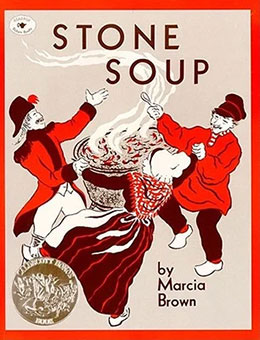
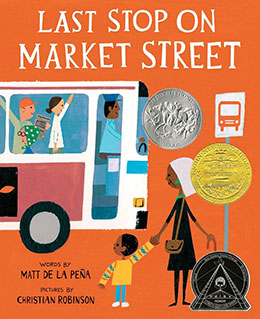
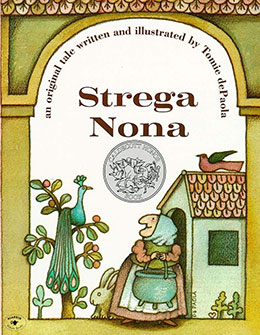

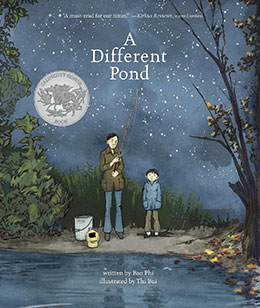
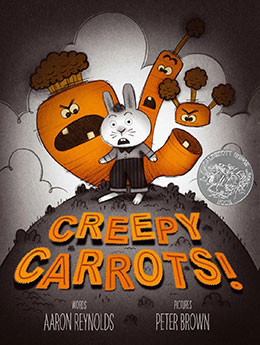

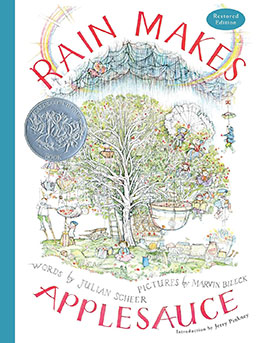


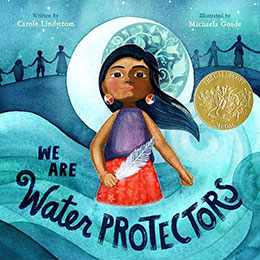
I love sooo many of these books. “Thank You, Omu” is a new FAVORITE! When I read it to my granddaughters they repeat “Knock, knock, knock” and “thick red stew” as I come across those phrases. So fun, and such a meaningful, important book to share.